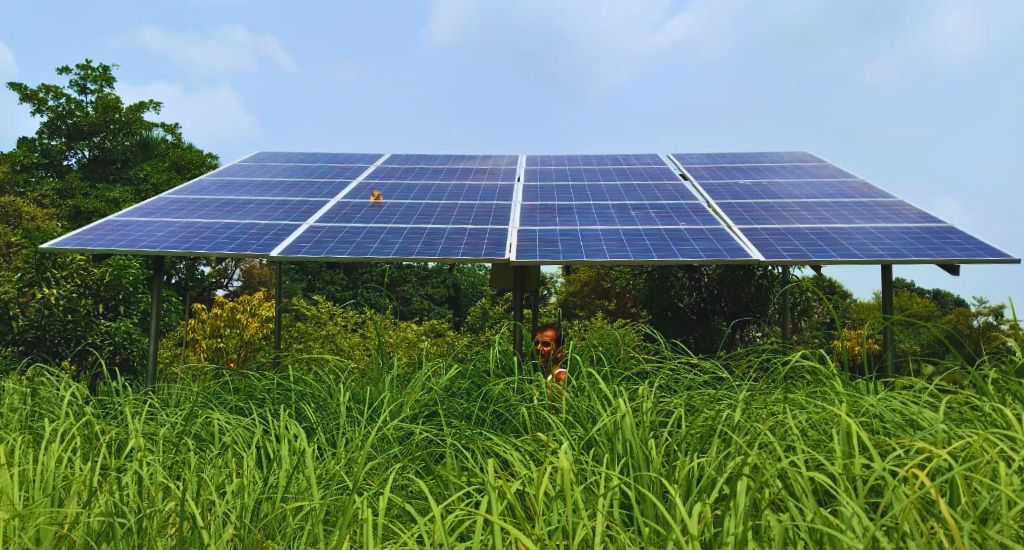
Sun comes to the aid of poor farmers
Solar power irrigation has emerged as a sustainable solution for the rural poor farmers but several technical, social and organisational challenges need to be tackled to ensure a wider reach.

Solar power irrigation has emerged as a sustainable solution for the rural poor farmers but several technical, social and organisational challenges need to be tackled to ensure a wider reach.
In several large swathes of land in India, agriculture is rain dependent. Flow irrigation from canals cannot reach these areas due to their hilly and undulating terrain. These regions include not only places that are deficient in rainfall but also many other areas such as Chhattisgarh or Jharkhand which receive a lot of rain. They are all homes to poor, marginalised and neglected communities such as Dalits, tribal people, etc.
Their only hope of increasing income from farms is to use the surface water that is available seasonally or to rely on groundwater. Electricity supply for farm irrigation has been beset with its own set of problems and is seen to work only in favour of large farmers.

Diesel and other fuel prices have also been rising rapidly. This leaves very little option for the poor farmers living in such areas. Solar power, which has near zero recurring cost, is ecologically friendly and can be availed practically anywhere in our sun-rich country. It is a wonderful solution available to poor farmers. The recent development of irrigation based on solar power exploits this opportunity.
The PM-KUSUM website mentions that over 2.4 lakh “standalone group pumps” and 1,519 individual pumps that run on solar energy have been installed. Group installations have reached a reasonable volume. The area irrigated may be around 5 lakh hectares. While the number is small compared to the potential of millions of acres which can benefit from solar powered irrigation, it is sufficiently large to show its desirability and challenges.
Also Read: How farmers flourish with community-owned solar-powered irrigation system in UP’s Bahraich
Group solar schemes comprise a set of solar panels mounted on rigid iron angle frames powering 3, 5 or 8 HP pumps that draw water from wells with depth up to 75 feet. Some schemes with submersible pumps in tubewells have also been experimented with. The water that these pumps can draw ranges between 60,000 to 1.4 lakh litres a day. Individual schemes with relatively small and portable solar panels have a rating of about half HP and can discharge water up to 30,000 litres in 8 hours, the modal period of availability of usable sunlight.

A typical flood irrigated field crop grown by medium and large farmers needs an average of 2 inches of water in one irrigation. This amounts to about 500 cubic metres or 5 lakh litres per hectare. Therefore solar powered irrigation is not appropriate for irrigation of large land areas in the conventional method. So solar powered irrigation is seen to be adopted by small farmers growing vegetable crops on small plots of land, usually under half an acre. Such crops need frequent irrigation rather than periodic flood irrigation.
The chief advantage of solar power irrigation equipment is that the recurring costs are near zero. However these systems are not entirely free of challenges. Carrying panels and the pump for portable small pumps can be quite tedious. Repeated transportation can cause damage to the panels, reducing their life from the promised 15-20 years.
In case of fixed systems, security can remain a challenge even though communities using them keep them inside a fenced space. For very poor marginal landless communities that practise only sharecropping, earmarking land for installing fixed solar panels is a huge challenge.
Since the amount of power generated varies according to the intensity of sunlight and cloud cover etc, the effective pressure at which water is drawn and released in discharge pipes varies. So the solar pumps by themselves are not best suited for drip irrigation.
Also Read: Solar-powered water supply eases women’s struggles

Any breakdown in the pump requires it to be shipped to the supplier from these remote locations and this poses a break in the schedule for a few days. The issue of repairs can only be resolved when people skilled in the job are available close by. This can happen as the number of these pumps rises. The other issues can be addressed by the communities themselves.
Communities will take sufficient interest in these systems if they are persuaded that it will help them increase incomes significantly. While solar powered irrigation expands cropping calendar, work is needed for ensuring quality inputs and advisory on choosing the right crops and marketing it. Where this has happened, solar powered irrigation has worked very well.
Also Read: Tribal dairy farmers prosper with ‘solar-irrigated’ fodder
The lead image at the top shows a solar power panel installed in a Chhattisgarh village. (Photo by Kuntal Mukherjee)
This article is based on the discussions held during a webinar on “Experience with solar power-based irrigation for the rural poor” organised on August 29. The interaction was moderated by Sanjiv Phansalkar, director, Vikas Anvesh Foundation, and featured the following speakers:
Victor Lesniewski, CEO and co-founder, Khethworks; Santanu Dutta, team lead, Odisha, Collectives for Integrated Livelihood Initiatives; Anil Kumar Verma, chief functionary, Preservation and Proliferation of Rural Resources and Nature, Gaya; Kuntal Mukherjee, integrator, Chhattisgarh, Pradan; and Sushant Pushkarna, regional Director (South Bihar), Sarva Sewa Samity Sanstha